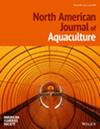Partial dietary fishmeal replacement with soy products in grow‐out ‐stage Burbot
IF 1.3
4区 农林科学
Q3 FISHERIES
引用次数: 0
Abstract
Abstract Objective The primary objective of this study was to determine how soy products affect Burbot Lota lota maculosa growth and gastric evacuation. The secondary objective was to determine the digestibility of common soy products in Burbot. Methods A 130‐day feed study was conducted with subadult (grow‐out stage) Burbot to evaluate performance with 25% of the dietary fish meal replaced with soybean meal or soy protein concentrate compared with a control diet formulated to resemble a salmonid diet. Additionally, diets from the feed study, along with chironomid meal (a natural forage item), were used to determine Burbot gastric evacuation rates using fish naive to soy. These diets, containing over 12% soy, were applied to fish from the same cohort of Burbot used in the initial feed study. A digestibility assessment was conducted using diets with 30% of the fish meal replaced with soybean meal, soy protein concentrate, and a fermented soybean meal. Result No differences in growth performance were observed. The gastric evacuation assessment revealed that soy protein concentrate was evacuated at a significantly higher rate than chironomid meal; however, no other differences in gastric evacuation rates among diets were detectable. Apparent digestibility of protein was significantly higher in the soybean meal, soy protein concentrate, and fermented soybean meal treatments relative to the control diet. Apparent lipid digestibility was significantly lower in the soybean meal diet relative to the control diet; however, neither diet was significantly different from the soy protein concentrate or fermented soybean meal treatments. Conclusion Soy protein is highly digestible in grow‐out‐stage Burbot, these fish can be produced to market size on diets with ≥25% of the fish meal (relative to the experimental control diet) replaced with soybean meal or soy protein concentrate with no impact on growth performance relative to a salmonid diet formulation.在生长阶段用豆制品代替部分饲料鱼粉
摘要目的本研究的主要目的是研究豆制品对黄斑白鳕生长和胃排液的影响。第二个目的是确定Burbot常见豆制品的消化率。方法采用亚成虫(生长期)Burbot进行了为期130天的饲料研究,以评估将25%的鱼粉替换为豆粕或大豆蛋白浓缩物与类似鲑鱼饲料的对照饲料的性能。此外,饲料研究中的饲料,以及chironomid meal(一种天然饲料项目),用于测定Burbot胃排出率,使用未经大豆处理的鱼。这些饲料中含有超过12%的大豆,应用于最初饲料研究中使用的同一群Burbot鱼。采用以豆粕、大豆浓缩蛋白和发酵豆粕代替30%鱼粉的饲料进行消化率评估。结果两组生长性能无明显差异。胃排空评价结果显示,大豆蛋白浓缩物的胃排空率显著高于手旋虫粕;然而,不同饮食的胃排空率没有发现其他差异。豆粕、大豆浓缩蛋白和发酵豆粕处理的蛋白质表观消化率显著高于对照饲粮。豆粕饲粮的表观脂质消化率显著低于对照饲粮;然而,两种饲粮均与大豆浓缩蛋白或发酵豆粕处理无显著差异。结论大豆蛋白在长出期Burbot具有较高的消化率,在将≥25%的鱼粉(相对于试验对照饲料)替换为豆粕或大豆蛋白精的情况下,这些鱼可以达到市场尺寸,且相对于鲑科饲料配方对生长性能没有影响。
本文章由计算机程序翻译,如有差异,请以英文原文为准。
求助全文
约1分钟内获得全文
求助全文
来源期刊
CiteScore
2.50
自引率
0.00%
发文量
46
审稿时长
18-36 weeks
期刊介绍:
The North American Journal of Aquaculture publishes papers on new research and practical experience in all areas of intensive and extensive fish culture. Topics include broodstock selection and spawning, nutrition and feeding, health and water quality, facilities and production technology, and the management of ponds, pens, and raceways.
The journal will consider papers dealing with ways to improve the husbandry of any aquatic species—marine or freshwater, vertebrate or invertebrate—raised for commercial, scientific, recreational, enhancement, or restoration purposes that may be of interest to practitioners in North America. Its scope includes both basic and applied science, but applied scientific endeavors—including practical experiences, descriptive studies, and other nontraditional, but pertinent works—are emphasized.

 求助内容:
求助内容: 应助结果提醒方式:
应助结果提醒方式:


